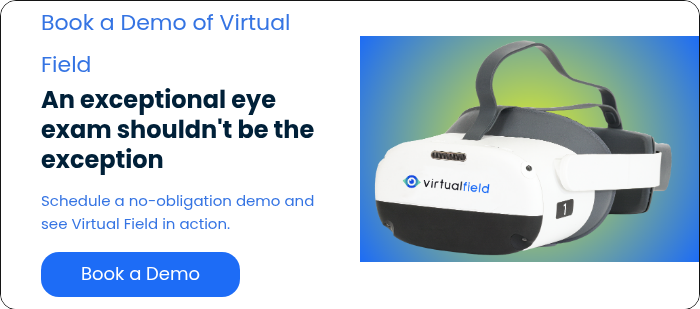National Eye Exam Month is more than a calendar reminder. It’s a strategic opportunity for education, engagement, and practice growth. Throughout August, patients are more attuned to messages about eye health, making it an ideal time to reinforce the importance of comprehensive eye exams that go beyond a basic refraction.
One of the most effective ways to add clinical value during routine exams is by incorporating functional testing, such as a visual field test. These tests help detect early signs of serious eye and neurological conditions, often before structural damage is apparent or symptoms are noticed. For practices aiming to elevate their standard of care and strengthen patient relationships, integrating and promoting visual field testing during this awareness month offers measurable benefits to both clinical outcomes and operational success.
The Importance of National Eye Exam Month
National Eye Exam Month, observed each August, provides a timely opportunity for eye care professionals to elevate awareness about vision health and the role of comprehensive eye exams. As mentioned, patients tend to be more receptive to educational messaging during this period. They’re also more likely to prioritize scheduling appointments, which makes it a valuable window for outreach and engagement. For practices, this month presents a strategic touchpoint to re-engage at-risk individuals (e.g., those with chronic conditions like diabetes or hypertension, a family history of eye disease, or a history of concussion) who may otherwise delay care.
Beyond increasing exam volume, National Eye Exam Month allows clinicians to reframe the purpose of comprehensive eye exams as preventive care. It’s an ideal time to emphasize the value of functional testing, such as the visual field test, in identifying early signs of glaucoma, neurological issues, and other hidden deficits. By leveraging this awareness month thoughtfully, eye care professionals can drive patient action, deepen clinical impact, and foster long-term relationships rooted in proactive vision care.
The Role of Functional Testing in Routine Exams
Functional testing evaluates how well a patient sees, beyond what structural imaging can reveal. Common tools include visual field testing to assess peripheral vision, color vision tests to detect cone function abnormalities, and contrast sensitivity testing to evaluate the ability to distinguish between subtle differences in shading. These assessments offer valuable insight into a patient’s visual performance and can reveal issues that traditional acuity tests and imaging may miss.
Pairing functional testing with structural exams such as optical coherence tomography (OCT) and fundus photography is critical for early and accurate diagnosis. While imaging reveals anatomical changes, functional data helps detect:
- Glaucoma Progression: Glaucoma progression is often first apparent as peripheral vision loss on a visual field test before structural thinning is seen on OCT.
- Neurological Vision Loss: In cases of neurological disease, visual field testing can uncover characteristic patterns of vision loss, such as bitemporal hemianopia in pituitary adenomas.
- Visual Field Defects in Systemic Disease: Functional deficits can also indicate systemic conditions, such as contrast sensitivity loss in diabetes, even when retinal structures appear normal.
Critically, many patients remain asymptomatic in the early stages of the disease. A patient may present with 20/20 visual acuity but have undiagnosed peripheral vision loss due to early glaucoma. Including functional tests in routine exams ensures subtle yet significant deficits are not overlooked.
How Virtual Testing Makes It Easier
Virtual visual field testing offers a streamlined alternative to traditional bowl perimetry, addressing several barriers that often limit the efficiency and accessibility of routine functional testing. Conventional perimetry can be time-consuming, physically uncomfortable, and require significant technician involvement. These are all factors that can discourage both patients and staff from completing regular visual field assessments.
Modern virtual platforms simplify the process with shorter exam times and intuitive, headset-based designs that are easier for patients to tolerate. This feature is particularly valuable for pediatric patients, older adults, and individuals with neurological conditions who may struggle with conventional testing setups. These systems often integrate seamlessly into pretesting or follow-up workflows, allowing practices to increase clinical efficiency without overextending staff or disrupting the exam schedule.
During National Eye Exam Month, virtual visual field testing can be an excellent way to engage first-time patients or screen at-risk individuals without the logistical burdens of traditional methods. By reducing friction for both patients and providers, virtual testing supports a higher volume of functional assessments while maintaining diagnostic value and enhancing the overall exam experience.
How to Promote Functional Testing in August
To drive greater visual field testing awareness and acceptance among patients, practices can take several targeted steps.
Equip Staff With Clear, Consistent Messaging
Front desk and clinical staff should use consistent language to position visual field testing as part of a proactive health strategy, not just a follow-up for disease.
A sample script might include: “During National Eye Exam Month, we’re emphasizing functional testing to help detect subtle changes in your vision that standard exams might miss. It’s a quick, important step in protecting your long-term eye health.”
Leverage Email and SMS Campaigns
Use email and text messaging to educate patients ahead of their appointments. Messages can clarify that routine exams now include functional assessments like visual field testing for a more complete view of eye health. Focus on the idea that modern eye exams go “beyond a vision check” to detect issues before symptoms arise.
Reinforce Messages In-Office
Signage or digital displays in waiting areas can help normalize functional testing. Highlight that National Eye Exam Month is the ideal time to establish a baseline, particularly for patients at higher risk due to diabetes, high myopia, or a family history of glaucoma. These touchpoints reinforce that visual field testing is not just for older adults or those already diagnosed. It’s a critical tool for early detection and better outcomes.
Conclusion
National Eye Exam Month isn’t just a reminder to schedule a checkup; it’s an opportunity to deliver more complete, proactive care. By emphasizing comprehensive eye exams that include functional testing, practices can go beyond the basics and provide meaningful insights into a patient’s visual health.
Tools like virtual visual field tests improve diagnostic accuracy, uncover early signs of eye and neurological conditions, and help patients better understand their results. These benefits not only support early intervention and stronger clinical outcomes but also foster trust and long-term patient engagement. Virtual testing, in particular, removes logistical barriers and expands access to care, making it easier to incorporate functional assessments into every routine exam.
As practices promote these capabilities during National Eye Exam Month, they reinforce the message that eye care is about more than seeing clearly – it’s about protecting vision before problems arise. This August, embracing functional testing can help elevate the standard of care for every patient.
About Virtual Field
Virtual Field delivers an exceptional eye exam experience. Eye care professionals including ophthalmologists and optometrists examine patients faster, more efficiently, and more comfortably than ever before. Exams include Visual Field, 24-2, Kinetic Visual Field (Goldmann Perimetry), Ptosis, Esterman, Color Vision, Pupillometry, Extraocular Motility (EOM), and more.


